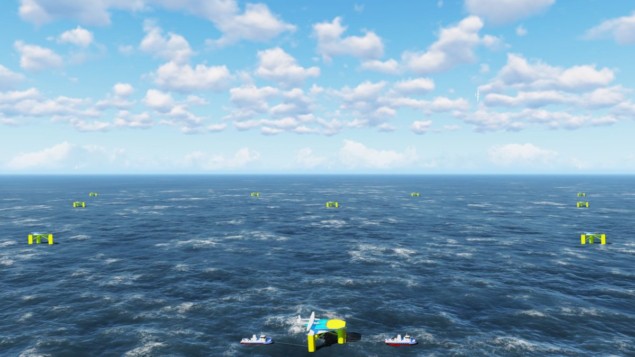
The Ekati Diamond Mine burns around 5000 litres of diesel per hour. Because of the mine’s location deep in Canada’s sparsely inhabited Northwest Territories, 200 km south of the Arctic circle, all of that fuel must be brought in on trucks via an ice road that operates for only two months every winter. The logistics of transporting and storing up to 50 million litres of diesel every year are eye-watering, and so are the costs: around the world, remote communities and facilities like the Ekati mine spend a total of $50bn on diesel every year, at an approximate cost of 30 cents per kilowatt-hour compared to grid power at 3–5 cents.
Rolf Luchsinger, a physicist and CEO of a Switzerland-based start-up firm called TwingTec, thinks that wind energy could take a bite out of those costs. However, installing large wind turbines at the Ekati mine is a complete non-starter: just imagine trying to bring in several 75 m-long turbine blades, plus a mast and a crane to lift everything with, via an ice road. And even in less challenging remote locations, where putting up turbines might be technically feasible, the enormous transportation and installation costs mean that facility owners and community leaders are financially better off sticking with diesel.
For TwingTec and a number of like-minded firms, the solution is to do away with the masts, blades and rotors of conventional turbines in favour of aircraft that fly around harvesting energy. These craft – TwingTec’s device is a drone; another firm, Ampyx Power, uses a fixed-wing aeroplane; other companies are developing kites or flying rotors – are tethered to the ground via a cable. As the craft gains altitude, the cable unwinds, driving a generator in the process. When it reaches the end of its tether, the craft is pulled back in like a giant yo-yo and the pumping cycle starts again.
My introduction to the idea of airborne wind energy came at this week’s IDTechEx conference in Berlin, Germany, where TwingTec, Ampyx and hundreds of other hi-tech firms were showing off their latest ideas and products. The conference programme was highly eclectic, taking in areas such as printed electronics, sensors and 2D materials as well as off-grid energy. As it happens, I came to Luchsinger’s talk straight from a much more conventional lecture on coin-cell batteries for wearable healthcare devices, and I initially found the contrast in tone and ambition a bit of a shock. However, once I’d wrapped my head around the idea that aircraft could generate power, rather than simply using it, I was intrigued enough to stick around for additional talks by Kristian Petrick of Airborne Wind Europe, Richard Ruiterkamp of Ampyx Power and Rogelio Lozano of Bladetips Energy.
All of these companies (and several others besides) seek to exploit the fact that wind speeds a few hundred metres off the ground are significantly higher than they are at the Earth’s surface. That means that airborne wind energy isn’t limited to a few choice sites around coasts and hills, and all four speakers waxed lyrical about the prospect of offshore floating wind farms populated by a slew of tethered craft circling (or figure-8-ing) serenely in the breeze.
To make a system on a 50 kW scale has been established, but the guidelines for scaling up have not been written
Richard Ruiterkamp, Ampyx Power
Getting there will, however, be a challenge. Ruiterkamp’s talk was especially interesting in this respect because Ampyx’s technology is relatively mature: the Netherlands-based firm is currently building a 150 kW aircraft with a 12 m wingspan, and they hope to demonstrate a multi-craft 2 MW system (comparable to a single commercial-scale wind turbine) by the mid-2020s. But Ruiterkamp, whose background is in astrophysics, was not making light of the difficulties involved. “To make a system on a 50 kW scale has been established, but the guidelines for scaling up have not been written,” he said. “You need to understand your system much better before you even try to fly it.”
Ruiterkamp went on to explain that the financial risks of getting things wrong with full-sized craft are much higher than they are with smaller, cheaper prototypes. A safety incident or crash could also be devastating for perceptions of the young industry; more generally, public reaction to airborne wind is, in Ruiterkamp’s view, “one of the most difficult things to model or simulate”. However, he also said that he didn’t envision the technology being deployed in highly populated areas, and in his experience of talking to people (including neighbours at Ampyx’s test site), “the fact that this is different gives us some benefit of the doubt.”
“Different” is a good word for it, and the harsh economics of off-grid energy mean that despite my knee-jerk initial assessment (basically, that the whole concept was as mad as a box of amphetamine-crazed frogs), I’ll go ahead and give airborne wind energy the benefit of the doubt, too. In October this year, Physics World will publish a report on energy technologies (part of our Physics World Focus series on physics-based industries), so stay tuned for more about this and other developments that could shape our future energy landscape.



